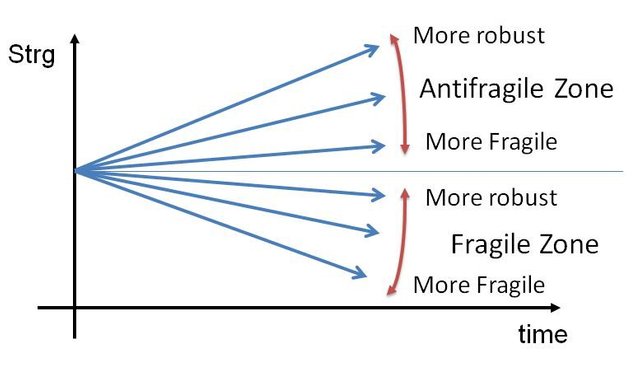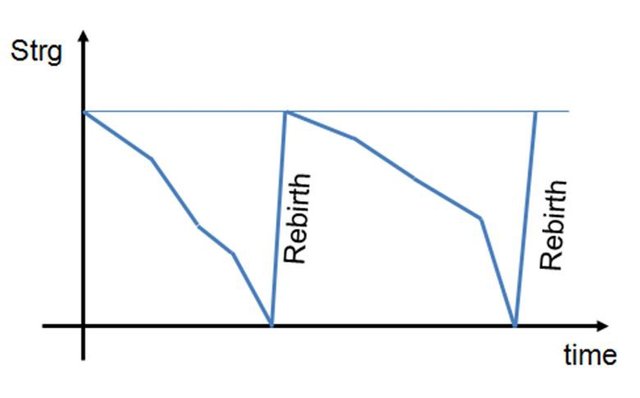When reading Antifragile by Nassim Taleb, I tried to make a visual representation of his descriptions of antifragility. It helps me to picture things to better understand them, so I did this with his concepts.
Here I am going to write down what I build in my head.
Fragile, Robust and Antifragile
The three main functions going through the book are fragile, robust and antifragile.
Fragile objects have low resistance to stress and will break fast, robust objects break less fast and antifragile objects become stronger over time when exposed to stress.

Fragile objects lose strength very fast, robust objects take more time and antifragile objects get stronger over time
So, I got some nice diagrams going, but what I asked myself was: can an antifragile thing be destroyed? Sure it can! But then what makes it much different to the others? Is it just the upwards slope?
Basically, if the slope is positive, the object is antifragile. If the slope is negative it is fragile and if the slope is 0 then the object could be described as perfectly stable. Thus I came to the following visual representation.

Fragility, robustness and antifragility thrown together
The ability antifragile thus is not just represented by another graph, but simply by the positive slope of strength over time. It is explained that the strength will increase over time while the object is subjected to stress. Same for the fragile, robust and antifragile object is, that it will break all the same if the stress is over the current threshold. If it wouldn’t, the object would just be indestructible and antifragility would not be necessary.
So how is the relationship between stress, damage and antifragility? Can we get closer to this ability?
Phoenix & the Machine
One of the examples occurring in the book is the one of the phoenix that is neither robust nor fragile nor antifragile. The rebirth of the phoenix makes it a special case in the relationship of fragility and antifragile.
This is how I see the strength over time for a phoenix.

As the phoenix grows older it will get weaker, accumulate damage if you will and finally die. The death itself will bring forth its own rebirth. I apologize beforehand if the narrative is different, but as I understand the Phoenix will come back as good as new, so the same as before.
Over long term, the phoenix is thus perfectly robust regarding his live. Death and rebirth viewed over a long time thus just form an infinite long horizontal line.
The phoenix reminded me on the function of a machine. Performing a task to the most possible ability, the machine slowly wears down until it falls under the accepted tolerance. By repair and change of tools, the machine is brought back to its former potential.
Obvious differences: the machine doesn’t die. Not even in metaphorical sense. There is a certain amount of damage that is worth repairing and if that amount is too high, the machine is thrown away, recycled or easily said: dead.
The other difference is the Theseus’ paradox of the machine, that doesn’t affect the phoenix, because the Phoenix rebirths himself without outside help. But is the machine still the same machine if every single part is replaced? And can the machine then be properly compared?
Neither the phoenix nor the machine is antifragile, but his ability for rebirth is similar to what we are looking for at the heart of antifragility.
So let’s look at another example.
Human & Technology
The ability of humans to adapt is inherently antifragile. Otherwise Taleb didn’t have to write his book. One of the multiple antifragile abilities is that of muscle adaptation to stress, which is easy to picture since the upcoming trends of multiple fitness styles.
The muscle is subjected to stress by working out. Afterwards it is supplied with sufficient nutrition and given some rest, and it grows stronger. As is known in strength training, the initial progress is very fast and then slows down while approaching a possible maximum amount of muscles.
I am aware of the multiple influences of nutrition, kind of training, training frequency, execution, rest, age, ect. So I just keep it easy for an example of antifragility.
Antifragility is included in the cycle of stress, destruction, repair and overcompensation. In comparison to the phoenix, we can see that this example has two differences to: The stress never fully destroys and the regeneration overcompensates.
Since the total destruction was also no part in the robustness of the machine, it can be crossed out for being a necessary condition for applied antifragility.
Thus for me, the ability to overcompensate is the core function of antifragility.
This effect can be seen in the relationship of humanity with technology: starting with simple sticks, humans were able to further craft more complicated tools to enable a more adaptability to their surroundings and soon live in every environment of the world, and even in space.
The steps of technology implementation, adaption and a phase of rest while encountering new problems drives the human species to ever further strength.So is this symbiosis of humanity and technology prone against any danger? Not at all: as we remember, the recovery from death only works for the phoenix. A damage high enough to wipe out the majority of the population could therefore throw back humanity to a level from where it can’t recover, or where its strengths are so diminished that humanity is overtaken by another, more able, species.
But is the increasing strength even worth it? While humanity can survive more dangerous encounters, it is also subjecting itself and its surroundings to more destruction. The question for me would be, if this is proper stress that can force humanity to more adaption.
So while humanities problems in the world increased and its impact on earth grew bigger, the possible dangers for it also went down. While a single plague, slight temperature change, political indifferences or geological event could easily bring down half of humanity a few centuries ago, an event right now for the same impact may be still as possible, but has to be of higher impact.
- Volcano eruption vs Super volcano eruption
- Crusade/Conquest vs Nuclear war
- Unusual long winter vs Global warming
- Plague vs Global biological warfare
- Rough sea vs Tsunamis
- Assassins vs Global terrorism
While this doesn’t mean that humanity is in less danger then before, it just means that is definitely increased its strength against impacts. A big increase in survivability will be the step of humanity to become an interplanetary species. While this will certainly bring more problems with it, like the possibility of interplanetary war, asteroid terrorism, ect. It will make humanity be a lot less fragile to global catastrophes.
Upvoted you
Downvoting a post can decrease pending rewards and make it less visible. Common reasons:
Submit
During my Bachelorthesis I read some stuff by Keith Swenson who used tried to explain antifragility regarding business processes. You can look in the tag cloud for antifragile https://social-biz.org/2013/06/01/slidecast-on-antifragile-systems-innovation-and-learning-organizations/
Imho he had some very nice and good explanation regarding antifragile systems
Downvoting a post can decrease pending rewards and make it less visible. Common reasons:
Submit
Thanks felixa!
Downvoting a post can decrease pending rewards and make it less visible. Common reasons:
Submit